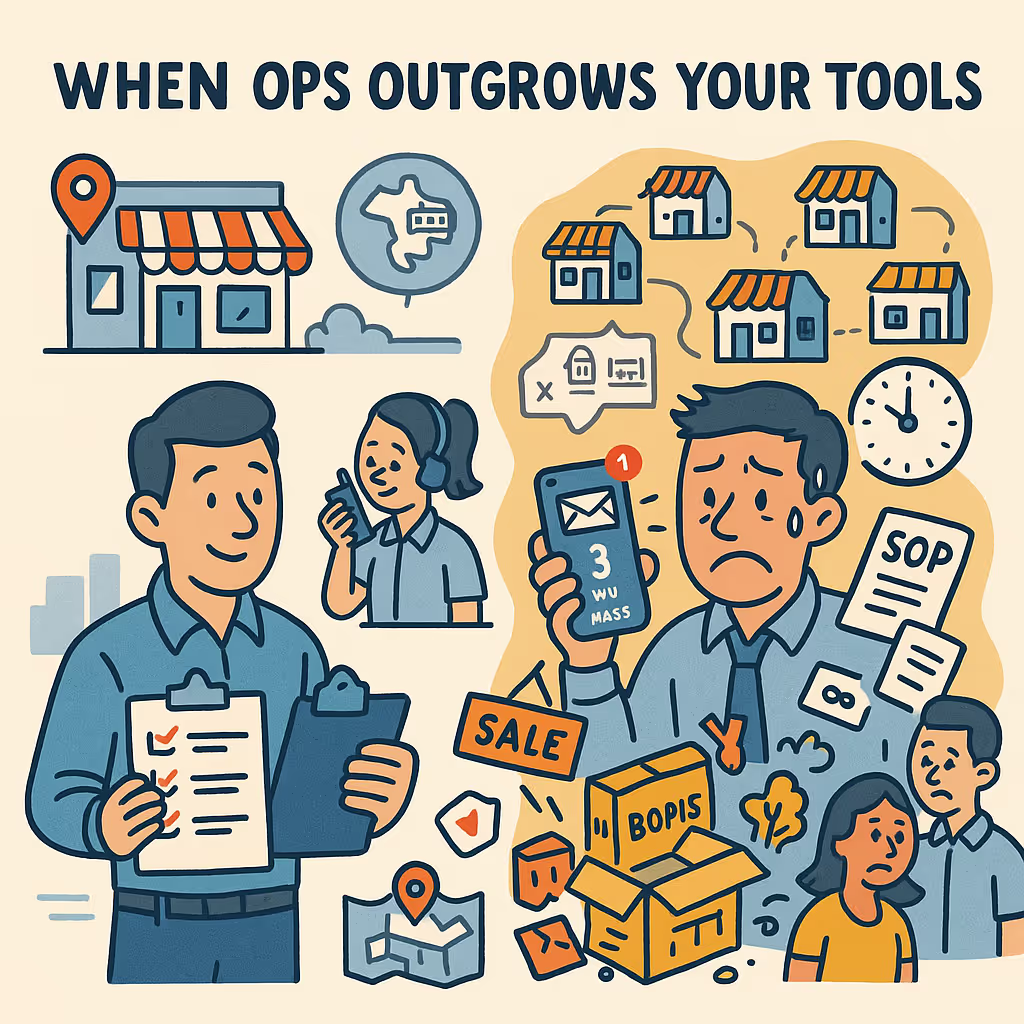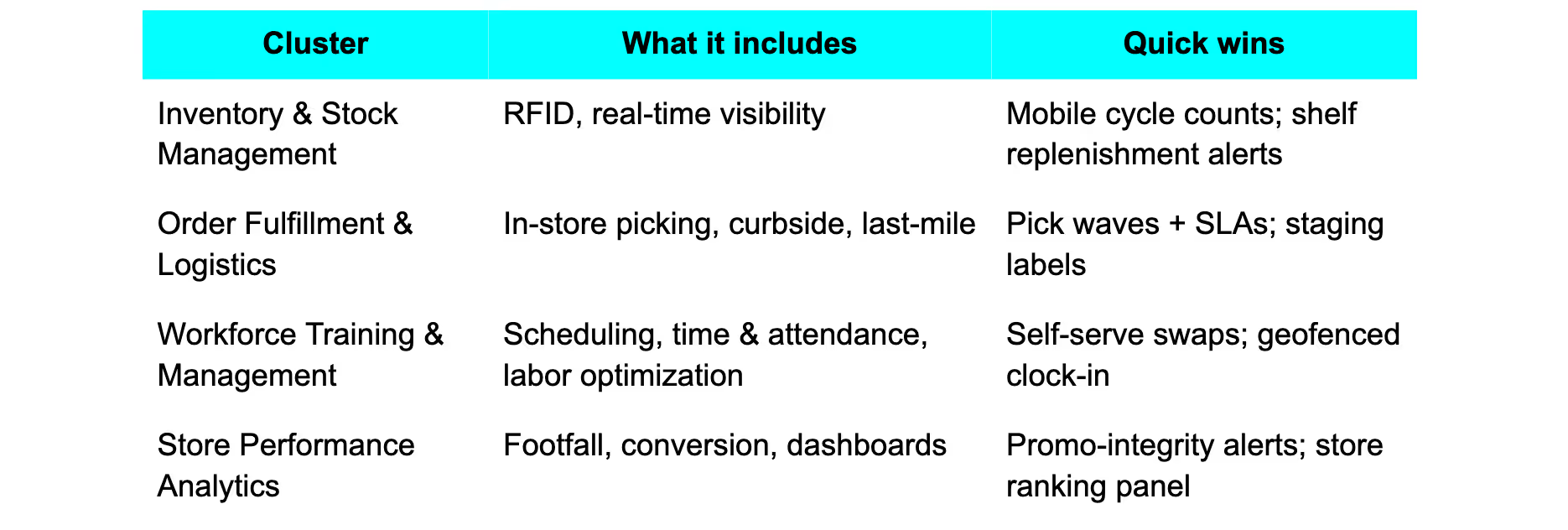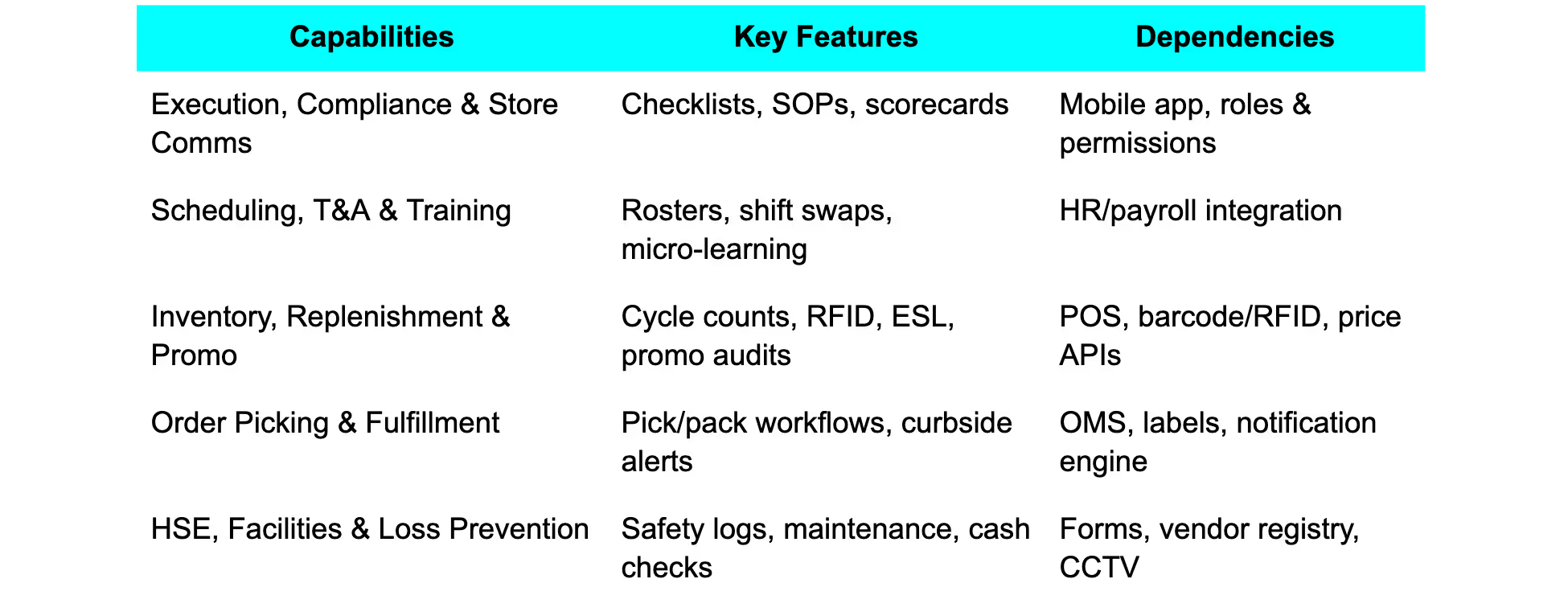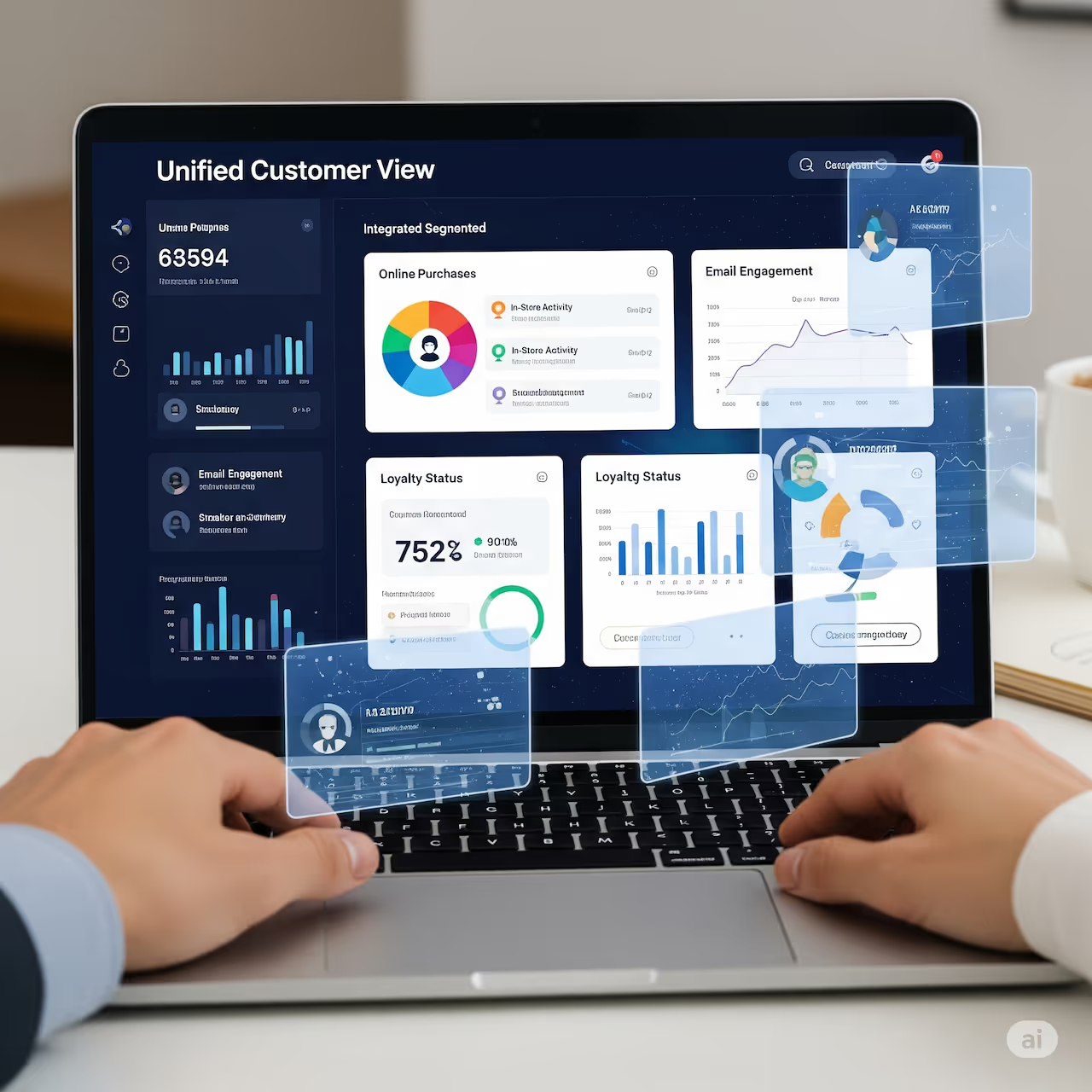Retail stores don’t break down because of one big failure. They break down in a series of small, unseen moments. Missed tasks, outdated checklists, slow handovers, decisions made without data- just to name a few.
A typical morning in retail could look like this:
A price update is due first thing in the morning, a vendor delivery hits the dock, shelf tags and planograms need verifying, cycle counts begin, a maintenance issue gets logged, and two associates call in sick. The manager juggles WhatsApp, a clipboard full of paper checklists, and a POS note on the till that no one owns. By noon, promo tags slip, counts drift, and queues build even with cashless payments. Such ad-hoc scrambles aren’t rare, they’re daily reality. And they get worse as you grow.
It’s not a lack of effort. It's a lack of systems.
Digitizing store operations is what turns this chaos into consistency. It replaces paper, spreadsheets, and bolt-ons with connected, mobile-first workflows that integrate with POS, HR, and inventory systems so frontline work becomes visible, measurable, and repeatable.
Who should care?
Mid-sized retailers expanding from a handful to multiple locations, managing 100+ frontline staff who need consistent execution across outlets. If your teams spend more time firefighting missed tasks, shelf out-of-stocks, staffing gaps, or compliance errors than focusing on customers and growth, then transforming your Store Operations becomes a priority.
Stop Scaling Chaos: When It’s Time to Digitize Store Ops
You don’t need to digitize every workflow from day one. But at a certain point, the cracks begin to show and manual tools just don’t scale.

If you’re starting to feel the strain of growth, here are the clear signals you’ve outgrown paper checklists, WhatsApp groups, and one-off fixes:
🔹 Growth Triggers
- You’ve grown from 1–2 stores to 5+ outlets
- You’re managing 100+ frontline employees across shifts and regions
- You’re introducing new formats like express stores, dark stores, or store-based fulfillment
- You’ve added BOPIS or ship-from-store models that stretch store capacity
🔹 Execution Gaps
- Promotions are set up late or inconsistently
- Planograms and cycle counts are still tracked manually
- Store audits, health & safety checklists, and compliance forms go incomplete or get skipped
- Big differences between top- and bottom-performing stores—without visibility into why
🔹 Operational Breakdown
- Managers are in firefighting mode, not leading or coaching
- Staff miss tasks due to unclear handovers or outdated SOPs
- Inventory mismatches, long queues, and manual returns frustrate customers
- Burnout and turnover are rising due to chaotic shifts and poor communication
If you’re experiencing three or more of these, you’ve likely passed the inflection point. That’s when digitization moves from being a nice-to-have to a non-negotiable foundation. It’s how you move from effort to consistency and from scramble to scale
Where to Digitize: Think in Layers Before Zones
Before you dive into digitization, anchor on three layers:
- Customer Experience Layer
- Store Operations Layer
- Foundational Layer that supports both
Map these to your physical and digital zones: checkout and payments, POS workflows, e-commerce, loyalty, inventory management, fulfillment, data & AI, security, and sustainability post which you can tackle the highest-leverage workflows first.
Here’s the full breakdown:
Customer Experience Layer

Store Operations & Back Office Layer

Foundational Layer

Bottom line: As you digitize, design for what’s next. Your core enterprise systems should work hand-in-glove with Store Ops, and the stack must plug-and-play new capabilities and auto-orchestrate work. In the agentic era, it shouldn’t just integrate; it should sense, decide, and execute.
What to Digitize: Standardize Core Workflows, Then Connect
Focus first on daily, repeatable workflows, then plug them into systems that make them fast, visible, and auditable.
Customer Experience Capabilities

Store Ops & Back Office Capabilities

Foundational Capabilities

How to Implement with Proof and Payback
Digitizing store operations isn’t a one-time switch, it’s a phased playbook. You start small, prove impact, then scale with structure.
# Phase 1: Start Small, Prove Fast (Weeks 1–6)
Begin with the basics. Digitize task lists, audits, and store communications in 2–3 pilot locations. The goal isn’t perfection—it’s proving that teams complete over 90% of tasks on time, audit rates improve, and frontline engagement increases. You should see high daily usage from both managers and associates within the first few weeks.
# Phase 2: Stabilize and Scale (Weeks 6–16)
Once the pilot proves value, expand the implementation across more stores. At this stage, add scheduling and time & attendance workflows, enable mobile receiving, and digitize cycle counts. This is also the point to wire up store-based fulfillment like BOPIS. Watch for key wins here: better shift coverage, improved stock accuracy, and faster fulfillment—ideally BOPIS orders fulfilled in under 15 minutes.
# Phase 3: Optimize and Automate (Week 16 onward)
With the core systems stable, shift focus to optimization. Introduce forecasted rosters, exception alerts, and automation triggers. Layer in AI-driven insights, computer vision for promo checks and floor monitoring, predictive maintenance workflows, and even clienteling features for staff. At this stage, you should see tangible business impact: higher sales per labor hour, reduced shrink, and 98%+ promo execution accuracy.
How to Evaluate Store Ops SaaS
Choose like an operator, not a demo tourist. Prioritize platforms that standardize daily work end-to-end, plug cleanly into your stack, and prove value fast. Then stress-test everything else.
Core Must-Haves
Start with mobile task checklists, automated scheduling, training modules, and dashboards. Avoid tools that digitize just one thing—like scheduling—without connecting the full workflow.
Integration Needs
Look for native integrations with POS, HR, and payroll systems. APIs for ERP and inventory must be clean and usable. Watch for hidden middleware dependencies or weak connectors.
Pricing & TCO
You want clear per-store or per-user pricing. Dig into the fine print—hidden integration costs, training fees, or long-term lock-ins can erode ROI quickly.
SaaS Maturity & Compliance
Expect 99.9% uptime, offline mode, and GDPR/PDPA compliance as baseline. Weak SLAs or hardware lock-ins are red flags.
Adoption & Training
It must work on standard iOS/Android devices with a mobile-first UI. If it’s clunky or tied to proprietary hardware, adoption will stall on Day 1.
10 Questions to Ask Store Ops SaaS Vendors
Don’t just evaluate features- stress-test readiness. These 10 questions will separate demo polish from operational reality:
- How do you support phased rollout across multiple stores?
Ask about templates, sandbox pilots, and balancing central standards with local autonomy. - What works offline, and on what devices?
Check BYOD compatibility (iOS/Android), shared/kiosk device support, and offline auto-resync. - Which systems do you integrate with natively?
Dig into POS, HR, ERP integration scope—and confirm if middleware, APIs, or no-code tools are available. - What analytics do we get beyond compliance?
Look for insights on labor variance, task exceptions, promo accuracy—and BI export capabilities. - Who owns the data, and how portable is it?
Clarify data export paths (CSV/API), throttling, and any hidden exit fees. - What AI features are live today and what’s next?
Ask what’s in production (auto-scheduling, exception alerts) vs what’s still roadmap-only. - How do you handle security and compliance?
Expect SSO/MFA, audit logs, ISO/SOC2, and GDPR/PDPA alignment as table stakes. - What localization and multi-geo features do you support?
Timezones, holidays, labor laws, RTL languages, and data residency options all matter as you scale. - What’s included in support and onboarding?
Understand SLAs (≤1-hour P1 response), multilingual help, 24/7 access, and what’s paid vs bundled. - What’s the full commercial picture: TCO, renewals, and hidden costs?
Ask about license tiers, integration fees, professional services, and notice periods upfront.
Digitization as the Store’s Operating System
Digitizing store operations isn’t about replacing people. It’s about giving them one connected way to run the day. For mid-sized retailers, it becomes the Store OS: a unified layer that standardizes execution, drives compliance, accelerates decisions, and protects margin.
This is how you will move from firefighting to forecasting- From missed tasks to measurable wins. Moreover, as the technology evolves within the agentic era, the best systems won’t just track tasks. They’ll sense, decide, and act.
Digitising the store operations is where this foundation starts.
Next Steps
- Run a quick self-audit: How many of your workflows still rely on WhatsApp, whiteboards, or paper?
- Map your triggers: Have you hit the inflection points—growth, complexity, inconsistency?
- Sketch your ideal day: What would your store look like if tasks, inventory, and staffing all ran like clockwork?
→ Start mapping your Store Ops Stack, and when you're ready, explore tools that can bring it to life.


.avif)


.avif)